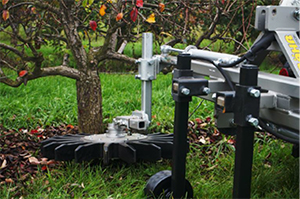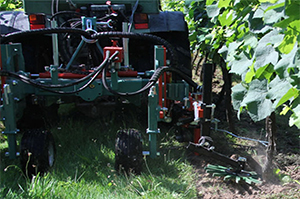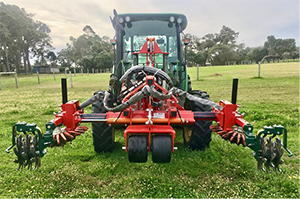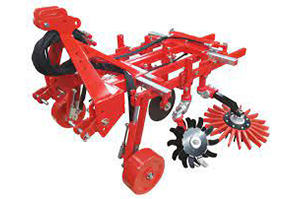Background
Several different tools are used by wine-grape growers across Australia to manage undervine weeds without chemicals. Most growers use a combination of equipment to achieve good weed control
Cultivation is commonly used for non-chemical weed control, with the finger weeder being a recent and popular innovation.
Action
The finger weeder has ground-driven flexible fingers which fit around the vine and uproot small weeds from the undervine area (Figures 1,2, 3 and 4).
A finger weeder can be used in combination with a ground-driven rotary star tiller or disc plough, which loosen the soil to improve the finger weeder’s action.
 Figure 1. Bähr finger weeder |
 Figure 2. Clemens finger weeder |
 Figure 3. Fischer finger weeder and rotary tiller |
 Figure 4. A Boisselet over row frame with finger |
Advantages and disadvantages
Advantages: Finger weeders are robust and have a fast-operating speed. Their shallow operating depth reduces vine root damage, and their flexible fingers cause minimal damage to vines. Finger weeders remove tufts of grass around trunks, providing medium-term control of weeds and do not require high operator skill to operate.
Disadvantages: Finger weeders mound the soil and may spread couch and kikuyu. Undervine cultivation can cause reductions in vine vigour in the first two years until the vine roots adjust by moving deeper into the soil profile.
Table 1. Advantages and disadvantages of a finger weeder
| Ability to reduce weed competition with vines | Good |
| Soil disturbance caused | Average |
| Suitability in young vineyards | Good |
| Length of weed control | Average |
| Operating speed | Good |
| Operating cost | Average |
| Capital cost | Average |
Considerations
When considering which weed control tools to use, it is important to base the decision on each vineyard’s individual characteristics. Factors such as soil type and condition, slope, rainfall and water availability, weed type and pressure, vine age, vine vigour, fruit end-use targets, weather conditions, and compatibility with existing infrastructure and equipment should all be considered.
Table 2. Ease of using a finger weeder on different soil types
| Large or excessive stones | Ok |
| Stone/gravel | Easy |
| Sand | Easy |
| Silt/loam | Easy |
| Clay | Ok* |
*Can be difficult in wet or very dry soils
Cultivation tips
- Control weeds when they are small.
- Any cultivation operation is most effective in hot, dry weather with dry soils.
- Multiple passes may be required if the soils are heavily compacted.
- Using a finger weeder in combination with other cultivation tools such as a disc plough or knife may be beneficial.
- Cultivation may be difficult in very wet or very dry conditions.
- Use an over row finger weeder frame like the Boisselet Acolyte over row weeder (Figure 4).
Growers’ experiences
Handpicked Wines in the cool climate region of the Yarra Valley, Victoria achieves good weed control using a Clemens knife weeder fitted with a rotary tiller head used in combination with a Clemens finger weeder fitted with a finger hoe on sandy loam soils over clay. The slower knife weeder (7 km/h) is used early in the season to cut weeds off underground and lightly cultivate the soil. The faster finger weeder (12 km/h) is used for several quick clean-up passes during the growing season. A more aggressive dodge plough is used every few years to clean up any tough weeds (such as mallow), which the knife weeder and finger weeder leave behind.
Bassham Wines in the hot, inland irrigated region of the Riverland, SA also uses a combination of a Clemens finger weeder fitted with a finger hoe and a Clemens knife weeder to manage undervine weeds in its organic vineyard. Four to five passes are carried out with the finger weeder during the season followed by one pass with the knife weeder. Both tools work well in the sandy loam soils. The flexible fingers of the finger weeder are particularly good for removing weeds from around the vine trunks while the two-sided knife weeder with sensors is used to reduce the mounding created by the finger weeder and to pick up weeds that the finger weeder has missed.
Resources
Organic Winegrowers New Zealand. 2017. Undervine weed management – A practical guide to effective weed control in organic vineyards
Contact
For further information, please contact:
AWRI helpdesk
Phone 08 8313 6600 Email helpdesk@awri.com.au

